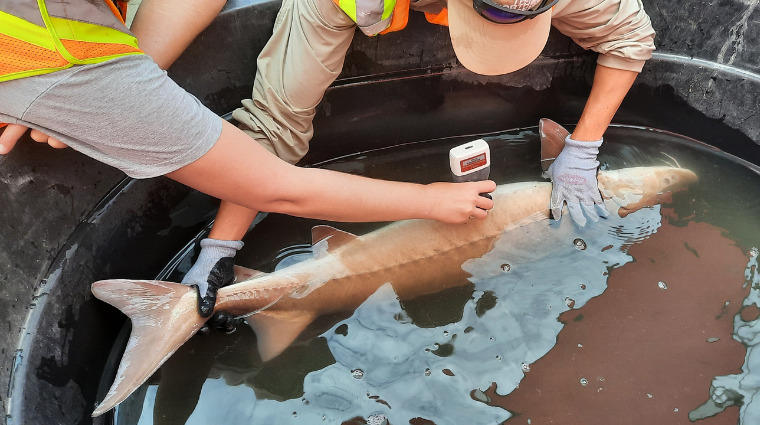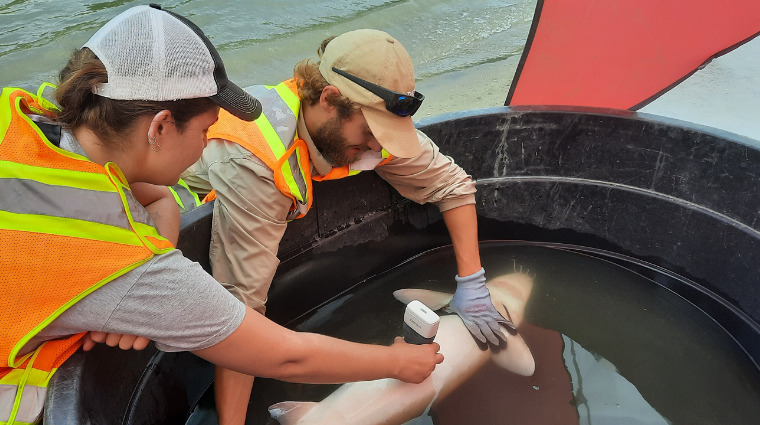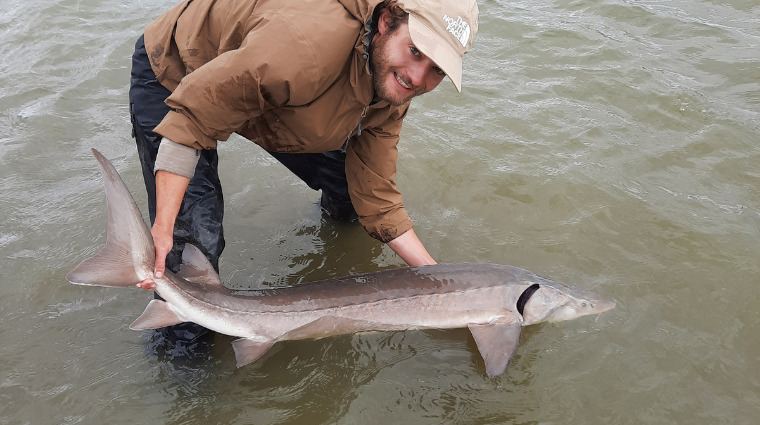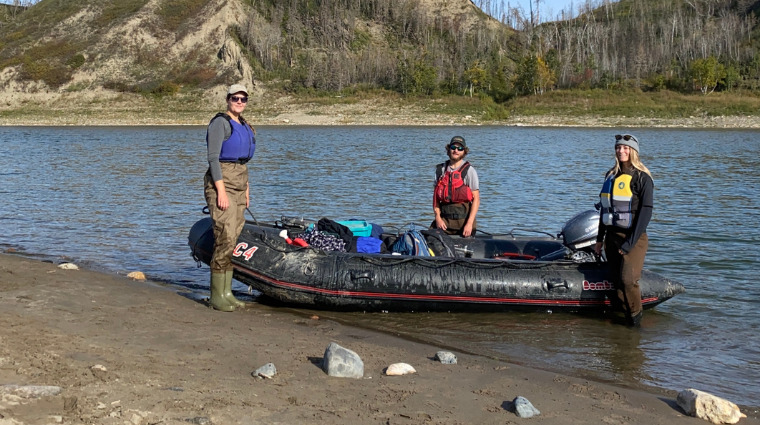
Applied research and passion converge on the North Saskatchewan River as researchers aim to forecast spawning cycles of Lake Sturgeon to help protect the species.
Saskatchewan Polytechnic is working to better understand and protect Lake Sturgeon. An applied research team, led by David Halstead, professional biologist and research chair, School of Natural Resources and Built Environment, is examining spawning cycles and generating demographic data of Lake Sturgeon in the North Saskatchewan River without using invasive sampling procedures.
Lake Sturgeon are designated endangered by the Committee on Status of Endangered Wildlife in Canada (COSEWIC). Environmental factors, over-fishing and intermittent spawning have been identified as factors leading to their endangered status.
“In order to protect Lake Sturgeon, it is important to safeguard and facilitate reproduction to the maximum extent possible,” notes Halstead. With Lake Sturgeon only spawning every three to five years, learning more about the species and finding ways to manage their habitat is crucial. “We have to be able to describe population demographics such as sex, age and spawning conditions, and must ensure there is sufficient habitat availability for spawning, rearing and development of succeeding generations on an annual basis,” he adds.
In addition to Halstead, the Sask Polytech team of six includes Darcy Lightle, fisheries biologist, Cole Tomlinson, research technologist, Bethany Koch, student researcher, Maycie McWillie, environmental intern and Leila Benmerrouche, research associate. Each member brings a unique background, skill set and undeniable passion for the work.
Both Koch and Tomlinson are recent Sask Polytech graduates that grew up near the North Saskatchewan River, which influenced their passions and career interests. “Growing up with the North Saskatchewan River right out my back gate, I have always been interested in science and nature,” says Koch. Upon graduation she was looking for an opportunity involving restoration or conservation efforts in habitats to protect wildlife. “I am really excited to be part of a hands-on research project assessing a species considered at risk,” she adds.
“I've been angling on the North Saskatchewan River for as long as I can remember. Its banks and waters have been a continuous source of inspiration for me in my pursuit of an environmental career,” says Tomlinson. “When the opportunity came to work on a project that I had dreamed about and that could have positive outcomes for what I consider its most fascinating species, I couldn't say no.”
Halstead notes that Tomlinson’s skills as both an angler and research technologist are relied on to sample the population while maintaining an emphasis on animal care, quality data and crew safety. Tomlinson takes the lead on field work. Along with Koch and McWillie, they spend the day on the water angling for Lake Sturgeon. They measure, weigh, capture images and PIT tag each catch before releasing it. Passive Integrated Transponder (PIT) tags are used for identifying fish and tracking movement, survival and growth over time.
In addition, the team is incorporating ultrasound technology into field research. It is impossible to distinguish sex of the fish without dissection or endoscopy. Ultrasound imaging allows the team to determine sex and reproductive conditions without the use of invasive techniques that further harm the species population.
Ultrasound fieldwork became easier with the addition of McWillie to the team in August 2021. A biology student at the University of Saskatchewan, McWillie took a year off school to gain experience in the field. “Capturing ultrasound images will bring insight for both male and female population numbers, as well as the sexual maturity of the overall population. I am excited to study the ultrasound imaging, as the project continues, we will gain a better understanding of the health of this at-risk population,” says McWillie. “Projects like ours are extremely important, this kind of work is where my heart is.”
With the species in peril, Halstead emphasizes safe handling and conservation are of the utmost importance, “Lake Sturgeon are equally at risk of damage due to the stress of capture and mishandling as they get older and larger.” Lake Sturgeon can grow to a substantial size and reach ages of 50 to 100 years old; as they age, they become more sensitive to mishandling. As the team performs fieldwork, they aim to have as little impact on the species as possible and use the least invasive methods for data collection.
As winter approaches, the team moves from field work to data analysis. This includes studying the internal anatomy of sturgeon through ultrasound images, interpreting data, Geographic Information Systems (GIS) mapping and more. At this stage, research associate, Leila Benmerrouche lends her expertise in GIS and remote sensing to help map sturgeon distributions and derive additional detail from ultrasound imagery. The team is hoping this project will allow them to forecast future spawning intensities on an annual basis to have a better idea of Lake Sturgeon population demographics and habitat requirements.
“If this work helps our understanding of sturgeon biology and habitat use, it can have significant influence on how a fish species is managed, and how we approach habitat conservation,” says Darcy Lightle, a professional biologist and part-time fisheries instructor with Sask Polytech’s Natural Resources Technology program. “The outcomes of this study could influence what and how conservation tools are used in work with industry.”
The three-year applied research project is in its second year and relies on partnerships and funding. The project is funded through a Natural Sciences and Engineering Research Council of Canada (NSERC) Community and Colleges Innovation Applied Research and Development grant of $180,000. “This project would not be possible without matching cash and in-kind commitment by Husky Energy, now a subsidiary of Cenovus Energy, Inc.,” says Halstead. “We’re extremely grateful to our partners at Cenovus for their enthusiastic support of this project and their willingness to provide the necessary funding and assistance.”



Sask Polytech's natural resources Applied Research services provide industry partners with the technological tools and analytical expertise that can propel them toward greater understanding and enhancement of the natural environment.
To learn more, visit saskpolytech.ca/research.
Published November 2021.
Saskatchewan Polytechnic is signatory to the SDG Accord. Sustainable Development Goal alignment is one of the ways Sask Polytech is leading the rise of polytechnic education.


